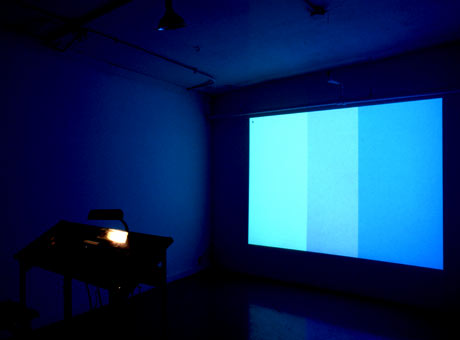Cory Arcangel, Amy Barkow, Clare Churchouse, eteam, Joe McKay, Jason Mombert, Chad Silver, Greg Simsic, Lynn Sullivan
Performance by Cory Arcangel during the reception
Outpost is a group exhibition of local, underexposed artists employing a wide range of mediums and approaches to art-making. Outpost has several different definitions, both military and public, however, in the popular imagination, outpost conjures images of the great frontier- groundbreaking settlements and stations for refueling. By nature, the outpost is fluid, transitory and a work in progress as it is set apart from the main social body as an outlying settlement.
The exhibition was conceived of as a platform for each artist’s work to become an individual outpost. The works they create are sites of navigation and generate activity in a language of familiar forms, many of them culled from popular culture. As an outpost itself, Smack Mellon is a perfect place to foster and support this
exhibition.
Greg Simsic stages mini-narratives using materials and tools found within his studio. His videos can be read as a commentary upon studio practice. The clinical approach he uses in documenting that practice plays with opening up the studio as a site of intimate and academic practice. He will be installing a group of monitors piled on top of one another which will create a ‘wall of dense activity.’
Jason Mombert’s ‘new sincerity’ conflates the hipness of irony until it morphs into complete absurdity appealing to our over saturation with images where every friendly gathering looks like an MTV party.
As Chad Silver scans his apartment in search of characters hidden in its walls, crumpled clothing, and ceiling tiles, he invites the viewer into fantastic micro-universe in which a paper towel is scary owl. His work is not absurdist, but touchingly sincere as we accept his invitation to search out playful characters that inhabit his personal landscape.
Cory Arcangel describes his data diaries as ‘watching your computer suffocate and yell at the same time.’ His diaries, which include 31 days of his computer data files, are created by playfully ‘fooling’ QuickTime into reading memory files as video files. They are like digital dreams, the pure shapes and tones of real computer memory with each video documenting a new day and offering us a new set of memories. 31 days will be available to be viewed during the exhibition.
Joe McKay blurs the boundaries between painting, digital art, and play through creating a computer program, which can run on its own or be played as a game by audience members who compete to match colors at varying levels of difficulty. As the levels intensify the ‘painting’ takes on a more complex and layered form.
eteam presents an ongoing installation in which visitors to the gallery can be integrated into a desert landscape. The viewers’ visit to the desert is limited as its inhabitants are added and will eventually disappear to make room for new visitors. The performance invites audience participation and continues throughout the length of the exhibition.
Amy Barkow approaches the subject of studio and gallery space by removing the exterior information from the surfaces to look at the materials underneath. She will create a site-specific installation using one of the walls of Smack Mellon in which she will penetrate the interior, hidden space and put a live video feed that we can watch. In addition, she will then use the residue from that wall to create a sculptural form.
Clare Churchouse is interested in the hybrid area between drawing, painting and installation and will create a site-specific work probing the use of actual versus illusionary space incorporating familiar found objects. Through using the real structure of an actual door Lynn Sullivan toys with notions of the familiar and the unknown by exploring the tensions between mundane objects and fantasy. The cellar door is not a space for the projection of fantasy, but can instead function as a more private and guarded enclosure of fantasy as well as a sculptural form unto itself.
